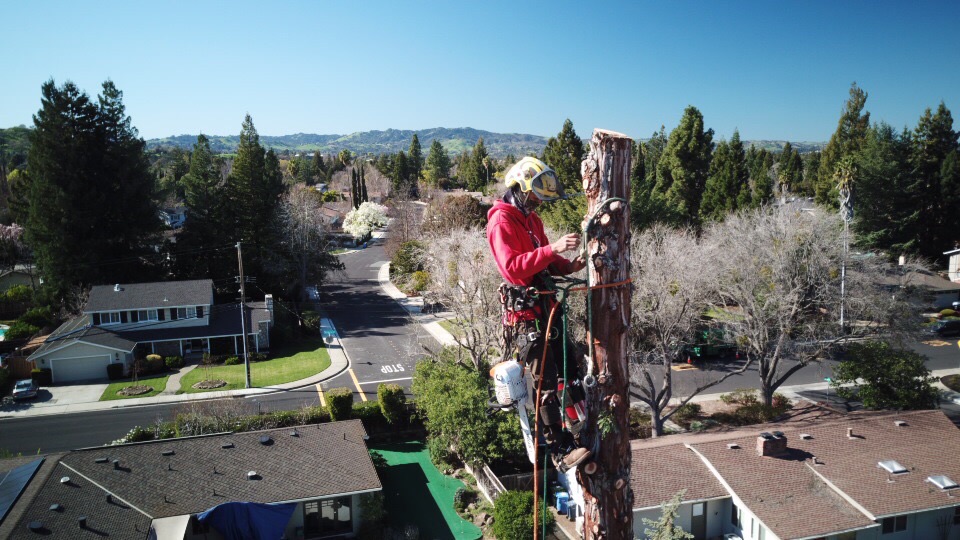5 Things to Ask a Tree Service Company

Prior to hiring a company to service the trees on your property, be sure to ask plenty of questions. Photo: Summit Tree Care ©2019
Before hiring a company to service the trees on your property, there are several things you’ll need to inquire about, from licensing and insurance to scheduling and payment. However, there are a few questions many homeowners don’t think to ask, but should. Here are five things to ask a tree service company:
1. How experienced is your team?
When it comes to working with trees, the stakes are fairly high. After all, trees are living things, which is why tree service technicians have more in common with physicians than handymen. That’s why it’s important to hire a tree service company that possesses an adequate level of knowledge and experience in its field. Improper maintenance (such as pruning at the wrong time of year) and outdated methods (such as tree topping) can lead to major consequences for a tree’s health, so you only want a well-versed professional servicing yours.
One way to get added assurance is to hire a tree service company that has a full-time ISA Certified arborist on staff. Having undergone a rigorous certification process, ISA Certified arborists possess demonstrable expertise in tree care. A certified arborist’s knowledge can be a valuable asset for ensuring accuracy with tree assessment and service, as well as for making important decisions.
2. Do you clean your tools between jobs?
Some tree service technicians may perform multiple jobs without cleaning their chainsaws and other tools, but this is irresponsible and risky, as contaminated tree service equipment is a common catalyst for the spread of tree diseases like sudden oak death. Make sure the company you hire responsibly maintains all tools and equipment by sterilizing them between jobs.
3. Are my trees healthy?
Just as people should have routine physical exams, trees should receive ongoing health assessments to preventatively identify disease, malnourishment and other issues. Ideally, you should have the trees on your property assessed by a tree expert (preferably a certified arborist) once a year. Furthermore, ask them what kinds of signs and symptoms you should be looking for when performing independent assessments.
Some potential indicators of poor tree health include:
- An excess of brown leaves or needles, especially on the outside of the tree
- Hanging, drooping or cracked branches
- Defects on the trunk or roots
- An excessive amount of birds occupying the tree, which may indicate an insect infestation
- The presence of “fruiting bodies” such as mushrooms and other external fungal growth
- Sparse or stunted growth
- Fragmented or peeling bark
4. What’s the expected lifespan of my trees?
Many homeowners assume that all the trees on their property have equivalent lifecycles, but that usually isn’t the case. It’s not uncommon for a homeowner to call a tree service company to perform maintenance on an ailing tree only to find out the tree is near the end of its lifecycle and needs to be removed.
To develop accurate expectations regarding the longevity of your trees, you’ll need to determine their species. For example, while the expected lifespan of a Leyland Cypress is only 20 years, a variety like Bishop Pine may live as long as 2,000 years. If you have a tree with a short lifespan, you need to be prepared to replace it in the future. On the other hand, if you have a tree that’s expected to live for hundreds or even thousands of years, you need to plan for the proper care and maintenance of that tree so it may continue to prosper in its environment.
Ask your tree service company to help you identify the species of trees on your property and provide guidance regarding your future choices.
5. What steps can I take to keep my trees healthy?
While routine professional service is a crucial part of tree care, even more important is the proper performance of ongoing maintenance. While measures like mulching and watering are beneficial to tree health, when performed incorrectly, they can be ineffective and even cause harm. For example, watering a tree’s trunk is pointless, and placing mulch too close to the trunk can increase the chances for fungus to develop. Since a tree intakes water and nutrients via its roots, which extend as far as its furthest branches, water and mulch should be applied to the outer perimeter of its canopy, an area known as the drip line. If you’re unsure how to properly maintain your trees, ask your tree service technician to educate you.
Sometimes, poor soil conditions and other factors can make it difficult for a tree to get sufficient nutrition. In such cases, a tree service technician may recommend using a deep watering tool, which delivers water and liquefied nutrients directly to the tree’s roots. Extreme cases of tree malnourishment may call for deep root fertilization, a professional service that utilizes hydraulic injection to deliver liquefied nutrients to the roots while simultaneously aerating the soil. Ask your tree service technician if your tree would benefit from deep watering or another supplementary irrigation measure.
Use Diamond Certified Resource to find top rated companies.
Local, Top Rated Diamond Certified Companies Related to Your Topic
Marin County Tree Service Companies
Sonoma County Tree Service Companies
Santa Clara County Tree Service Companies
San Benito County Tree Service Companies
Alameda County Tree Service Companies
Related Articles
The Homeowner's Guide to Tree Services
Get Expert Advice From Owners of Top Rated Local Companies
Become a Diamond Certified Preferred Member (Always Free)